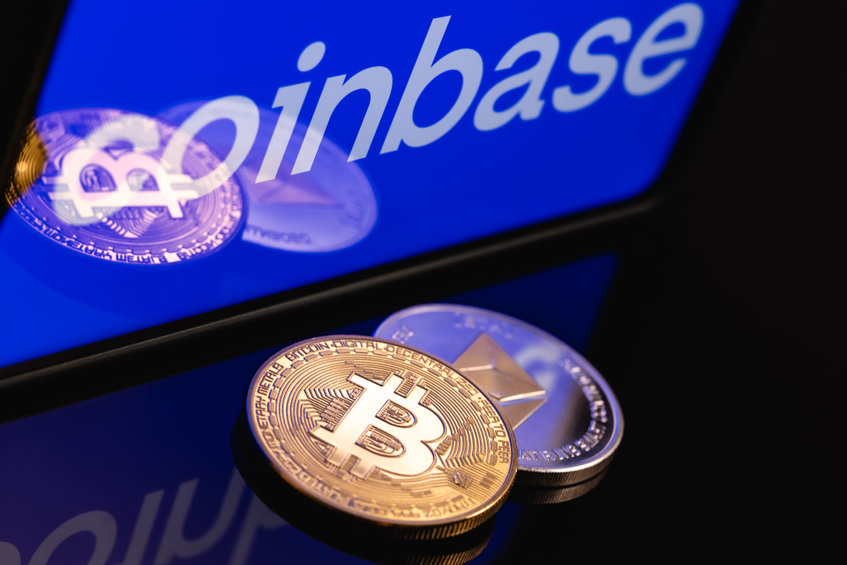Coinbase (and crypto’s) fate hangs by a string: A Deep Dive

Key Takeaways
- Coinbase is down 86% from its $100 billion IPO valuation
- It has significantly underperformed Bitcoin, Ethereum, the Nasdaq and almost every benchmark since
- This week it was sued by the SEC for violating securities law, its stock down another 27% from last week
- Coinbase went public under the SEC’s watch in April 2021, and the exchange sued the regulator two months ago for not responding to pleas for regulatory clarity
- Our Head of Research, Dan Ashmore, analyses the stock’s performance to date and writes about why the fate of the entire company is at stake
- The court case represents a huge day for crypto, Ashmore writes, and a much more intriguing case than the lawsuit Binance was charged with this week
Coinbase, the world’s largest publicly traded crypto company, closed last week trading at a price of $64.55. Then, the SEC came knocking.
The financial regulator sued Coinbase Tuesday, alleging it failed to register as a broker, national securities exchange or clearing agency, and is hence violating US securities law. Shares opened the next morning at $47.10, a tumble of 27% compared to that closing price the prior Friday (they had fallen 7.5% on Monday after Binance was sued).
Following a slight rebound, as of Thursday morning, Coinbase is trading at $53.26, its market cap $12.5 billion. That represents a painful 86% decline from its IPO in April 2021, when the company floated at a valuation of nearly $100 billion, or $381 per share. Ouch.
In a lot of ways, the demise of Coinbase sums up the entire cryptocurrency industry over this period. Since the top in November 2021, the space has been absolutely ravaged. A transition to tight monetary policy from central banks around the world, in response to rampant inflation, has pulled the rug out from under the industry (to use the crypto-native expression).
Despite allures of grandeur from certain investors during the pandemic (possibly dizzy from the explosive gains realised across the board as the Robinhood and cryptocurrency boom raged), Bitcoin and every other cryptocurrency trade like a high risk assets (at least for now).
Bitcoin may present as an intriguing discussion with regard to whether it ever can decouple, or take that crown of an inflation hedge. However, the reality is that as of 2023, everything in the cryptocurrency space is highly correlated and on the long end of the risk spectrum.
I compiled a deep dive on this point in March, when there were calls that Bitcoin was decoupling as banks were going under. All kinds of fancy correlation graphs were used, but sometimes there is no need to complicate things – look at this chart of Bitcoin vs Nasdaq over the last two years, which should show you all you need to know (please excuse the axis crime):
Coinbase’s stock was always going to fall if/when the crypto space pulled back – that is not rocket science as the lockstep relationship could be seen on the way up too. And as crypto took blow after blow, from Terra to Celsius to FTX and so on, prices collapsed and the wave of enthusiasm for these new digital assets turned into a trickle. For Coinbase, a company reliant on that enthusiasm, aka trading volume, for revenue, that amounted to a problem. And down the share price went.
In June 2022, Coinbase laid off 18% of its workforce. Six months later, it announced another round of layoffs, an additional 20% of the company chopped.
However, Coinbase’s fall signifies more than just the scandals of 2022, or the price collapses and risk mismanagement across the industry. It also highlights the travails of being a crypto company in the US today, and the increasingly regulatory hostile environment it is facing.
The precedent to the SEC lawsuit this week came in March, when the SEC issued a Wells notice (which typically signals legal action is imminent), after which the stock fell 25%. The company has repeatedly called for regulatory clarity, openly pleading with the SEC to provide clear guidance and clear up, among other things, where exactly cryptocurrencies tie in with current securities laws.
The next month, Coinbase went on the counter-offensive, suing the SEC and requesting the regulator be forced to answer a petition from July 2022 asking whether existing securities law could be extended to the cryptocurrency industry.
“Today, we filed a narrow action in the U.S. Circuit Court to compel the SEC to respond ‘yes or no’ to a rulemaking petition we filed with them last July asking them to provide regulatory guidance for the crypto industry”, wrote Paul Grewal, Coinbase’s chief legal officer, on Twitter.
Indeed, this is what makes the SEC’s case against Coinbase so captivating. I wrote earlier this week about how I believed Binance, which was sued by the SEC Monday, 24 hours prior to Coinbase, brought their regulatory troubles upon themselves. Binance is an exchange that operates in an incredibly opaque manner, such as refusing to provide information on its liabilities and operating without a physical headquarters, that is always going to draw the ire of regulators. Like it or not, that is the reality of the law in the US, and the SEC suing Binance should therefore have been widely expected both by the exchange itself and wider stakeholders in the industry (indeed, there are a multitude of cases and investigations ongoing against Binance’s various entities and executives).
However, for Coinbase, it is different. This is an exchange that floated on the Nasdaq in April 2021, under the SEC’s watch. It strived to comply with regulators, publicly challenging them to open communication lines and provide clarity. If the SEC are now accusing them of being an unregulated securities exchange, why were they allowed to float two years ago? Has something changed in the last two years that now renders Coinbase in violation of the law, where they were fully legal before?
I’m no lawyer – far from it, and these are genuine questions. I really don’t know, and that is why it presents as such a fascinating case, in contrast to the Binance one which seems like a typical regulatory complaint. Obviously, since FTX collapsed in November the regulatory regime has shifted, and that is not a surprise. I’ve said it before and I’ll say it again: the bulk of the cryptocurrency industry is a quagmire of insider trading, fraud and get-rich-quick-schemes. FTX elevated the prominence of this in the eyes of regulators, and the industry jumped to the top of the queue. Yet despite this, I still believe those aforementioned questions are valid – and that is what makes this impending court case riveting to me.
But make no mistake, whatever your beliefs about whether this is “right” or “wrong”, this is an existential threat to Coinbase as a business. One could go even further and speculate about the implications of what a loss in the courts for Coinbase would mean for the crypto industry as a whole in the US. Sure, crypto will live on, but how will centralised companies operate in the space thereafter? Why wouldn’t this notoriously location-agnostic industry just move overseas? And while that is possible, the loss of the world’s biggest financial economy to the crypto ecosystem – and the blockade on institutional cash that would therefore imply – would be a devastating blow. What Wall Street asset managers would care about crypto then? What companies would whack it on their balance sheet? Where…would it go?
These are challenging times for Coinbase investors. This is a company now valued at a measly $12.5 billion, the bubble of hysteria well and truly popped from those halcyon days when jpeg images were trading for hundreds of thousands of dollars, Tesla was purchasing bags of Bitcoin and trad-fi managers were frantically answering calls to start allocating to this nascent, dynamic and up-only asset class.
The below chart is telling when it comes to Coinbase specifically. It shows its 86% drawdown since its IPO in April 2021 against a variety of benchmarks, and it has underperformed every single one of them.
Bitcoin is down 59% since Coinbase went public. Ethereum has shed 20% (it more than doubled between April and November 2021). The tech-heavy Nasdaq is off 6%, while the S&P 500 has realised a slight gain at 3%. Even the quasi-Bitcoin holding vehicle that is Michael Saylor’s MicroStrategy has “only” peeled back 67%.
It’s not hyperbole to say that Coinbase investors from the early days of the company’s float could have chosen nearly any other asset and been better off (well, nearly all. Tokens such as LUNA and FTT existed).
Going forward, the picture has never been murkier. The macro climate is uncertain. While we may be coming to the end of the tightening cycle, rates have gone from near zero to north of 5% at a rapid pace, and monetary policy notoriously operates with a lag. There may still be pain to come – employment is still relatively tight and if the Fed is adamant to stick to that 2% inflation target, it won’t be an easy ride to get there.
And then, the regulatory picture worsens by the day. Coinbase will have their day in court, and it will be a big one. Not only for the stock, but for crypto at large. This is an industry that has seen its reputation dragged through the mud over the last year, with scandal after scandal and a total wipeout of prices, volume and wider interest in the space. It has never needed a win so bad.
Those holding onto those Coinbase shares are betting that win will come, but the challenges are multiple and the road ahead is steep. And that goes for the whole industry, not just Coinbase.





